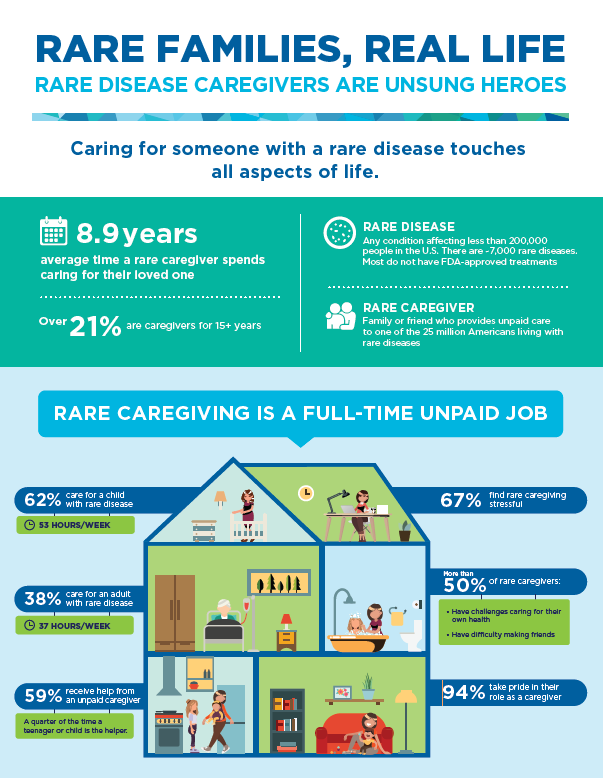Rare Disease Caregiving in America
 A few years ago, Grace Whiting of the National Alliance for Caregiving led an advocacy training at the Global Genes Rare Patient Advocacy Summit. She asked her group of trainees –
A few years ago, Grace Whiting of the National Alliance for Caregiving led an advocacy training at the Global Genes Rare Patient Advocacy Summit. She asked her group of trainees –
“Pretend like you’re having tea with the president, and you get to ask whatever you want. What would you ask?” she shared with the Travere Therapeutics team at a visit on Rare Disease Day in February 2019.
Grace was blown away at the summit by the sophistication of the rare disease community members as they fired back responses about accelerated pathways with the FDA and basic science research.
“And then one gentleman said to me,” she recalled, “‘I really wish there was something that described what we [caregivers] are going through in the aggregate.’ Out of that, and working with the founder of Global Genes, Nicole Boice, we developed a Caregiving in America study just on people who were caring for adults and children with rare disease.”
Rare disease caregivers are unsung heroes. For the estimated 25 to 30 million Americans living with a rare disease there is an army of caregivers supporting them. The National Alliance for Caregiving (NAC) in partnership with Global Genes set out to examine the issues and challenges facing those who provide unpaid care to someone with a rare disease. Travere Therapeutics is proud to sponsor this important research.
The study included quantitative surveys of more than 1400 caregivers who provide care to a child or adult with a rare condition. By gathering information from the perspective of the rare caregiver, NAC and Global Genes give voice to this unique group, and present the data in comparison to caregivers generally, where available. With this data, the rare disease community – including biopharmaceutical companies – are better equipped to advocate for and support their needs.
Basics of the Caregiving Situation
The report breaks down the demographics of the care recipient and caregiver. A snapshot:
- 62% care for a child under the age of 18
- 38% care for someone 18+
- 59% are parents who provide care to their own child under the age of 18
- 17% care for an adult child (age 18 or older).
- 14% care for a spouse or partner
- 9% care for a non-relative, or relative who is not their own child or spouse.
Navigating the Healthcare System
The study included numerous questions about caregiver interactions with medical professionals.
- 49% – Reported an experienced medical professional is needed and difficult to find.
- 35% – Reported it is difficult to find complementary or alternative treatments for their recipient’s condition
- 11% – Found that there is access to virtual healthcare provider visits for the recipient
Life-Changing Nature of Rare Caregiving
This section of the report provides a glimpse of the day-to-day impact of caregiving on the caregiver – hours of care provided, health and emotional well-being of the caregiver. These figures are presented in comparison to caregivers generally, for which NAC has previously undertaken research studies.
- Rare caregivers of adults spend: 36.7 hours a week providing care, compared to 24.7 hours for caregivers in general.
- Rare caregivers of children spend: 53 hours a week providing care, compared to 29.7 hours for caregivers in general.
67% of rare caregivers have a high caregiver burden measured on the burden of care index. The burden of care index is based on hours of care, number of activities of daily living performed (e.g., feeding, bathing), and number of instrumental activities of daily living performed (e.g., giving medicines, arranging services).
Of those who experience a high burden of care, the impact can be life changing.
- 75% experience a high level of emotional stress
- 65% feel it is difficult to care for their own health.
The Underlying Job of the Rare Disease Expert
This section of the report brings us detail as to types of activities and tasks performed – including medical tasks and condition monitoring, advocacy, and involvement in their care recipients’ participation in clinical trials.
84% perform medical/nursing tasks; half without any medical preparation.
Nearly all rare caregivers, whether caring for an adult or child, monitor the severity of their care recipients’ condition, advocate, and communicate with healthcare professionals on their recipients’ behalf.
An average of 89% educate healthcare professionals about their care recipients’ rare condition.
Finances
In this section of the report, readers discover the financial impact of rare caregiving. From cutting back on household spending, and using up personal savings, moving to a less expensive home, to filing for bankruptcy, rare caregiving is likely to cause caregivers to encounter numerous financial impacts.
The report provides case studies of rare caregivers of care recipients living with cystic fibrosis, Fabry disease, and pulmonary arterial hypertension. These three examples give a glimpse of how caregivers can have varied experiences based on the type of rare disease of their care recipient.
Concluding with policy recommendations, the reader sees a myriad of opportunities to help support rare caregivers. This section contains goals to address specific challenges, with tangible recommendations for policymakers, employers, medical professionals, clinical researchers and communities.
At Travere Therapeutics, we respect patients and caregivers for their courage to manage the care of rare conditions, and we acknowledge the impact on all aspects of rare caregivers’ lives.
Read the Rare Disease Caregiving in America Report.
Learn more about Grace Whiting and what she is doing for the rights of caregivers.
RET143